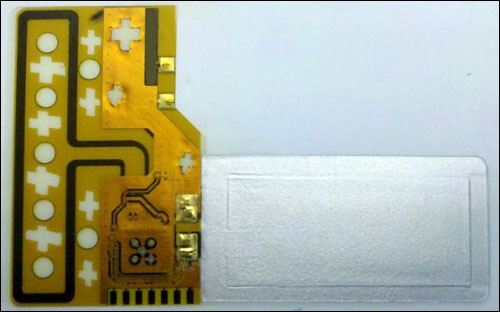Oct 05, 2010Novitaz, a company that provides marketing research services to the retail and hospitality industries, is preparing to launch a loyalty card containing an active 433 MHz RFID tag complying with the ISO 18000-7 standard. The NovitazInside Card would enable brands and retailers to provide targeted promotional offers and discount coupons to consumers, based on their spending habits.
The cards are part of the Digital In-Store Ad Network solution that Novitaz plans to introduce in early 2011 at two clothing-and-accessory stores, as well as at one restaurant located at Santana Row, a shopping mall located in San Jose, Calif. If the system works as expected and is well-received by the stores and their customers, Novitaz hopes to make the deployment permanent, add additional Santana Row stores into the network, and begin marketing the solution to retailers nationwide.
Novitaz has been working on the solution since the company was founded in 2003. Only now is the technology ready for use by consumers, says Jayant Ramchandani, the firm's COO, following years of research and development to identify and then build the appropriate technology. With the resulting system, an RFID interrogator detects when a cardholder enters a participating store, by reading the ID number being transmitted by the active RFID tag of that person's card. The interrogator then forwards that card number to the Digital In-Store Ad Network software, where the cardholder's spending habits can be analyzed and matched with appropriate marketing offerings, such as price reductions or complimentary products or services. The software sends those offerings to the cardholder's cell phone, in the form of text messages. The shopper can then use his or her phone to redeem those offers in the store.
During development, Ramchandani says, Novitaz sought the appropriate technology for an electronic loyalty program that would offer personalized savings in a manner similar to how the Internet functions. The company determined that an active RFID tag was the only technology that could transmit data without requiring a consumer's participation, such as swiping a card or presenting it to a reader. With an active tag, he explains, the shopper could simply walk through the store's entryway, carrying the card in her wallet inside a purse or bag, and receive personalized marketing. The system at Santana Mall is expected to go live on Jan. 15, 2011.
At each of the three participating locations, Novitaz will install its own RFID readers and antennas, in order to read cards as they pass through the door. The restaurant and two retailers will not pay for that installation, or for the hardware required. Each business will receive 500 cards to distribute to its regular customers, who then register their card by providing the retailer with their name, address and cell phone number. The store then passes that information to Novitaz, which saves the data on the Digital In-Store Ad Network software running on its own server, where it is linked to an encrypted ID number encoded on the tag.
The Digital In-Store Ad Network software can store details about the promotional offers on which the user clicked, as well as about which of those offers resulted in a purchase by that individual, if the retailer chooses to retain that data. The more often the consumer visits the store and responds to offers, the more personalized the offers can become—such as sending that person promotions for products and brands similar to the ones he or she previously clicked on or purchased.
"The advantage to the consumer is that they just walk in the store," Ramchandani says. "There are no apps to download—we've made this very simple for them." For brands and retailers, the system offers a greater boost in sales than they would achieve using paper coupons. For restaurants, he states, "the objective is to bring traffic in." The restaurant is then billed for each cardholder who comes through the door after receiving a promotional offering. In the case of the retailers, he adds, Novitaz charges them according to the number of customers who receive promotional text messages, and then again based on the number of offerings clicked on, or coupons redeemed.
The next step for Novitaz, following the Santana Row deployment, is to provide the same card to more businesses at the mall. The company also intends to begin marketing its NovitazInside Card to additional retailers around the United States, and to eventually offer its technology to be incorporated into a retailer's credit cards, as well as major credit cards. "That would be our final step," Ramchandani states.
In preparation for the NovitazInside Card's Santana Row launch, the firm has joined the Dash7 Alliance, a group of companies that promote the use of the ISO 18000-7 standard for active RFID technology. Ramchandani expects that his firm will benefit from working with other alliance members that are focusing on technology for mobile phones. "Dash7 members are innovating at the chip level to incorporate NFC and 433 MHz transmit on a single chip," he says. "We want to leverage this to move to the phone platform." In several years, when NFC technology in phones becomes ubiquitous, he hopes Novitaz's loyalty-card application could be loaded onto consumers' phones containing NFC and active 433 MHz RFID chips.



